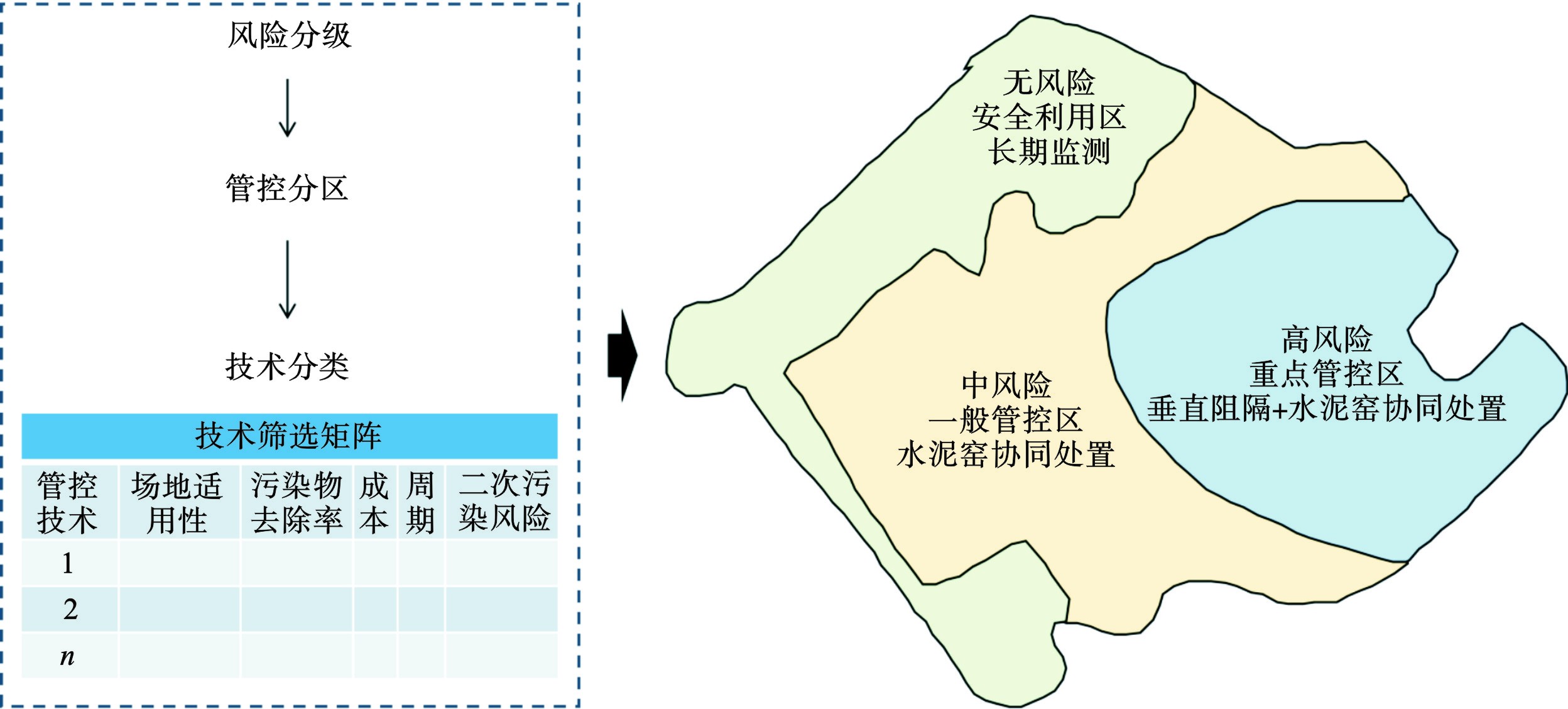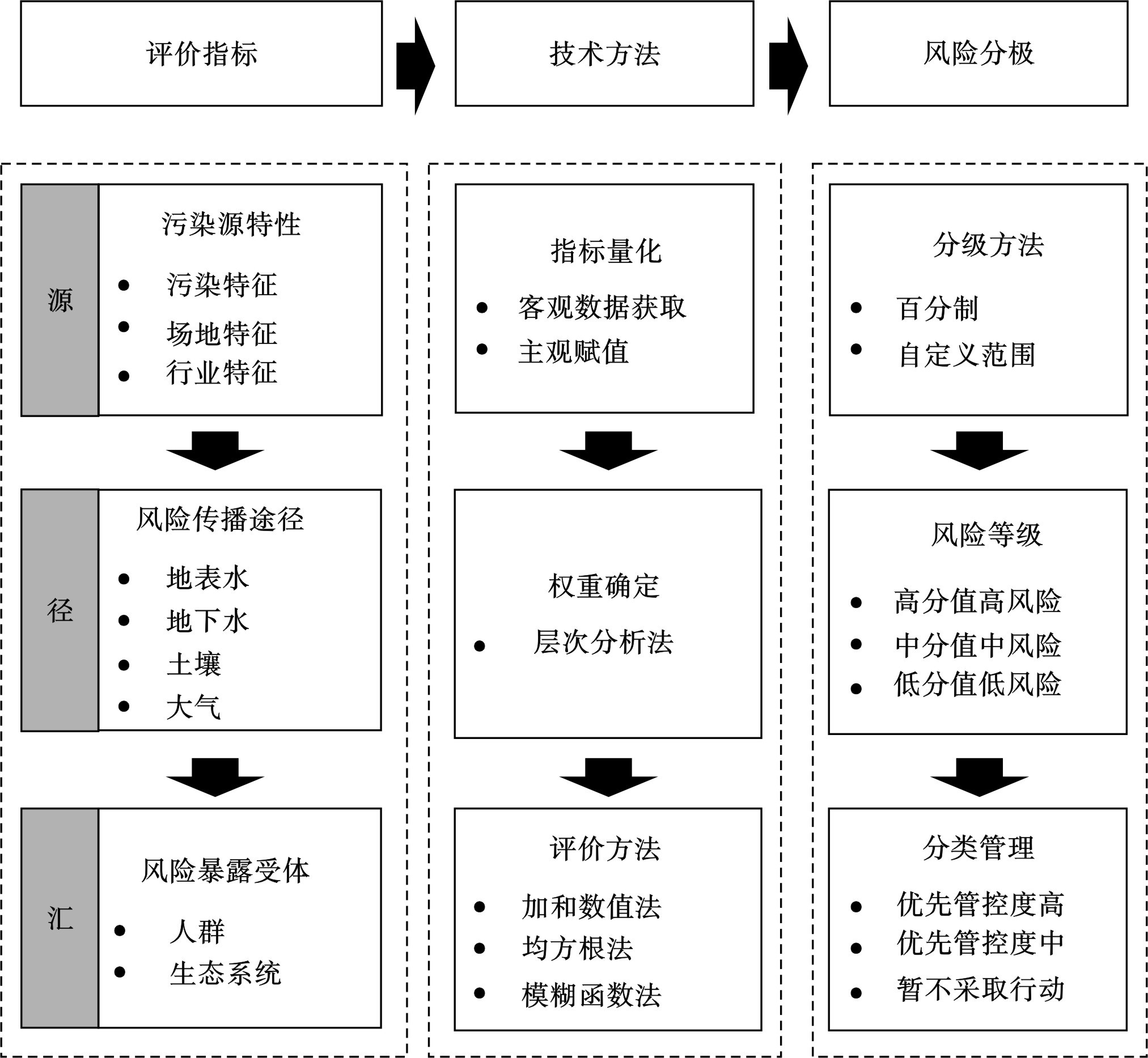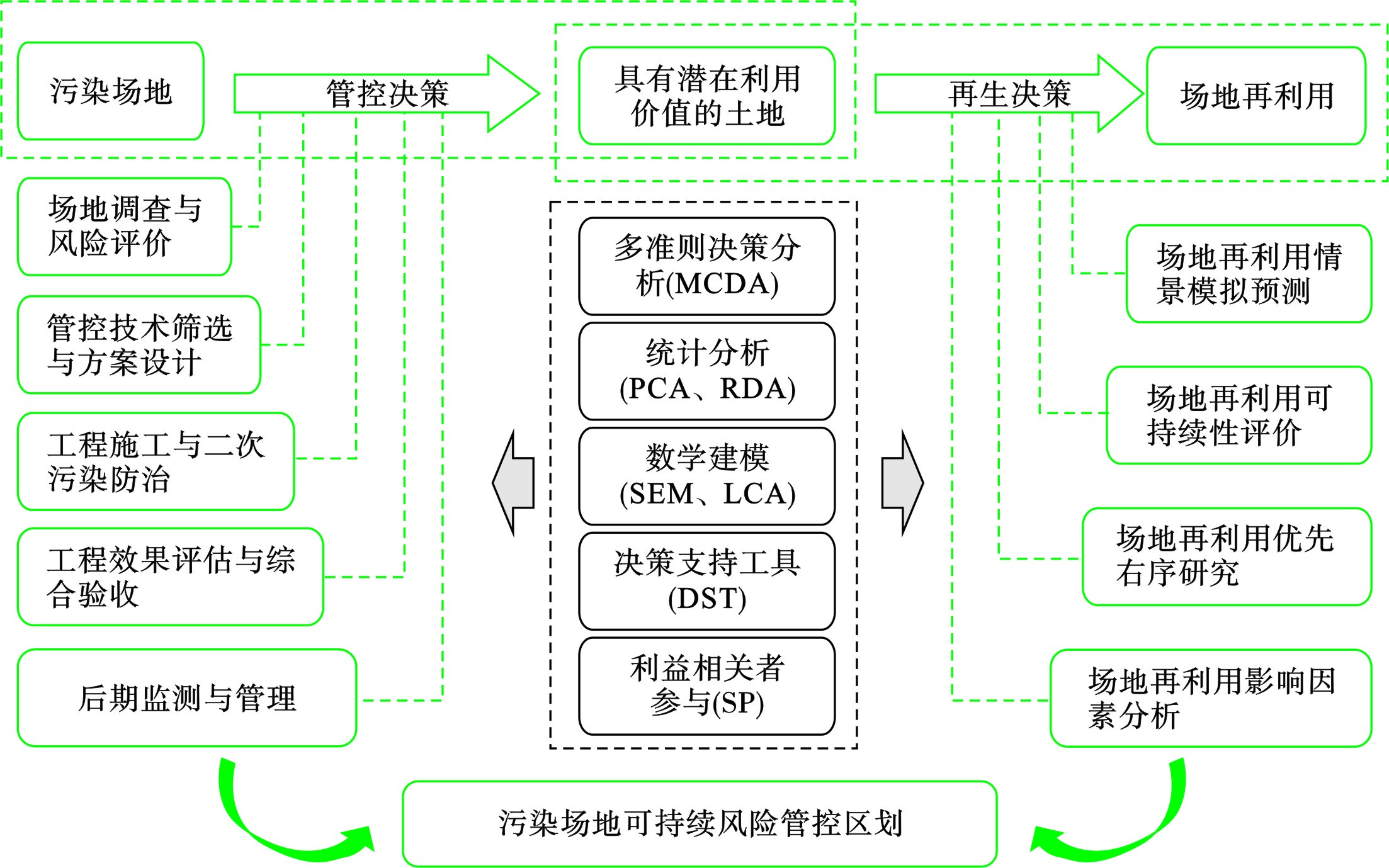-
随着产业结构的调整转型和“退二进三”“退城进园”相关政策的落实,城市化过程中企业的关停并转遗留了许多亟待修复和再开发的污染场地。污染场地是指由于堆积、存储、处理、处置或其他方式(如迁移)承载了有害物质而对人类健康和生态环境产生潜在威胁的空间区域,这一区域中有害物质的承载体一般包括土壤、地下水及地表水[1]。发达国家的污染场地修复工作起步较早,经过近半个世纪的探索实践与经验积累,管理思想逐渐从污染物彻底清除阶段、基于风险的管理转变为绿色可持续风险管控,主张风险管控技术在社会、环境、经济等多个维度的综合考量。对此,美国州际技术管理委员会(ASTM)、美国环境保护局(US EPA)、国际标准化组织(ISO)、欧洲工业场地修复网络(CLARINET)和美国、英国、荷兰、加拿大等国的可持续修复论坛(SURF)相继发布了一系列实践框架、标准指南和技术评估导则,形成了相对系统完善的污染场地可持续风险管控制度体系[2-6]。至此,以可持续发展理论和风险管理理念为基本原则的污染场地可持续风险管控已成为当前国际社会场地管理领域的重要决策问题和前沿趋势。
我国开展污染场地可持续风险管控的系统研究仅10年有余,虽然仍存在管控体系不完善、可持续影响机制考虑不足等棘手问题,但中国可持续修复论坛(SURF-China)的成立,加上《绿色可持续性修复指南》《污染地块绿色可持续修复通则》《土壤污染防治法》和土壤环境质量标准等系列文件的发布实施都极大地推动了我国污染场地风险管控行业的可持续发展[7]。“十四五”时期我国土壤生态环境保护形势依然严峻,对污染场地的精细化管理和可持续利用提出了更为紧迫的现实需求。然而目前,我国污染场地的污染类型、污染程度、地块数量和分布范围等地域差异较大,同时,污染场地的治理修复费用高昂,现阶段还不具备同时对所有污染场地进行彻底修复的经济实力和技术力量,因此十分有必要开展污染场地可持续风险管控区划研究和分类管理,识别出可持续发展潜力大的场地对其采取优先管控和再开发策略,以实现有限资源的优化配置,同时提高不同利益相关方风险交流、交互决策的有效性。
本研究通过开展污染场地可持续风险管控区划的国内外文献调研,对区划指标体系、区划分级方法、区划管理策略和区划工作流程等相关研究成果进行了系统梳理,将污染场地可持续风险管控区划路径归纳为基于健康风险评价的特定污染场地分区管控、基于风险分级的区域污染场地分类管理和基于污染场地再利用的风险管控区划规划决策等3个方面。可以看出,我国污染场地风险管控区划框架已基本形成,但在指标选取、方法应用和分类标准等关键环节仍存在主观分歧,目前国内还没有形成标准的、可推广的、可操作的区划管理体系与决策支持系统。最后,面向我国“十四五”对土壤环境分类管理的战略部署,紧密结合后修复时代污染场地风险管控的可持续发展趋势,构建契合我国污染场地环境管理实际的可持续风险管控区划体系概念模型,以提高土地利用效率、提升城市功能并最终推动区域社会经济的可持续有序发展。
-
由于同一场地也存在污染的空间异质性,因此十分有必要通过开展场地调查识别现场污染情况,准确掌握场地的污染物种类、分布范围和污染边界等,为精细化健康风险评价和后续分区分类风险管控提供科学指导[8]。健康风险评价是建立污染场地风险管理体系不可缺少的技术手段,以美国国家科学院(NAS)提出的“危害识别、剂量-效应关系评价、暴露评价、风险表征”风险评价四步法为基本框架,多个发达国家都结合本国国情和场地管理需求在此方法上进行了修正扩展,形成了包含污染物毒性与理化参数、健康风险评价方法和场地修复清理目标等在内的一套完整的污染场地风险评价体系,并开发了相应的风险评价模型与软件系统以方便应用,如美国的RBCA模型(Risk-Based Corrective Action)、英国的CLEA模型(Contaminated Land Exposure Assessment)和荷兰的CSOIL模型(Contaminated Soil)[9-11]。根据我国特定的区域环境与地质场景,中国科学院南京土壤研究所基于美国ASTM RBCA E2081、英国CLEA导则和我国 《建设用地土壤污染风险评估技术导则:HJ25.3—2019》研发了国内首套污染场地健康与环境风险评估软件(HERA),为我国实现可持续性土壤与地下水风险管控及综合利用发挥了重要的指导作用。
基于污染场地健康风险评价,通过全面了解场地边界内污染物在水平和垂向空间上的风险表征水平,按“风险等级划分、管控区划定和管控技术筛选”的基本思路开展污染场地风险分级分区管控[12-13]。污染场地风险分级-分区-分类管理概念模型,见图1。
(1)风险等级划分。关于风险等级划分标准,目前业内还没有形成统一认知。理论研究层面上,有学者探讨了土壤综合污染指数作为分类标准的可行性,而实际管控方案制定过程中,多以污染浓度、污染物类型和风险值作为直接分类依据,如,某铬盐厂按六价铬含量是否超过150 mg/kg划分重度污染和轻度污染,某军工厂按污染物的复合种类划分高风险和低风险。
(2)管控区划定。风险等级直接决定了对应风险区的管控关注度,一般按风险等级由高到低划分为核心管控区、重点管控区、一般管控区和安全利用区等类别,不同管控区的管控目标不同,因此风险管控策略也需“因区制宜”分类制定。如,某化工厂重点管控区以严格控制地块污染进一步扩散为管控目的,安全利用区则以污染预防预警为首要原则。
(3)管控技术筛选。污染场地治理所采取的风险管控技术和措施都是建立在相应的分级、分类基础上,进一步结合污染物去除率、治理成本、治理时间、土地再利用方式和二次污染影响等指标建立技术筛选矩阵,论证可行的风险管控技术。如,某铬盐厂重度污染土壤需先淋洗后还原稳定化,轻度污染土壤直接进行还原稳定化即可达到修复目标。
-
为解决污染场地数量庞大与管控资源短缺、修复费用高昂与高风险场地亟待修复之间的矛盾,世界各国积极探索基于风险的污染场地分类分级管理模式,通过划分风险等级有选择性地采取优先管控行为。美国是最早实行污染场地风险分级管理的国家,根据危害排序系统(HRS)的综合评分机制确定污染场地是否具备列入国家优先治理名录(NPL)的条件[14]。随后,加拿大、英国、法国和瑞典等国家也相继制定了符合本国实际情况的污染场地分类管理制度体系,并以污染场地分类机制为基础,进一步构建了污染场地档案数据库管理系统,以标准化的数据存储方式进行有效的场地管理决策。其中,美国的危害排序系统(HRS)和加拿大的污染场地国家分类系统(NCCME)是污染场地分类机制的典型代表,常被别国借鉴用于污染场地分类体系和管理模式的科学研究[15-18]。
国内对于污染场地分类管理的理论研究和实践经验较发达国家来说基础薄弱。在研究初期,我国学者主要是以评述国外分类管理系统为主,通过分析对比不同国家的分类体系,有针对性地提出适用于我国污染场地分类管理的经验和建议[19-22]。国家层面上,我国针对污染场地分类管理发布了 《关闭搬迁企业地块风险筛查与风险分级技术规定(试行)》《在产企业地块风险筛查与风险分级技术规定(试行)》等文件,明确了全国土壤污染状况详查重点行业企业地块的风险筛查与风险分级的技术要求,但也仅停留在政策宣讲阶段,距离全面推广落实还存在较大差距。总体来说,国内外已有分类体系构建思路大体一致,具体步骤见图2。
(1)从污染源特性、风险传播途径和风险暴露受体3个方面建立风险分级评价指标体系。其中,污染源特性指污染物毒性、污染严重程度、污染面积与深度等可能对人体健康和生态环境产生较大风险隐患的要素;风险传播途径指促使污染物到达或暴露于目标受体的大气、水体和土壤迁移等方式,受污染物挥发性、土壤有机质含量和地下水埋深等因素影响;风险暴露受体指受污染威胁的人群和生态系统,其易损性与人群暴露时间、生态区敏感性等特征直接相关。
(2)通过客观数据收集或主观赋值的方式量化评价指标,采用合理的技术方法计算污染场地总风险值。评价过程中,层次分析法是应用最普遍的指标权重确定方法,而总风险值计算方法的选取具有较强的主观臆断性,为克服传统打分法的缺陷,学者们开始探索各种综合评价方法运用的可行性,如,加和数值法、均方根法、模糊函数法和多准则决策等单一或联合评价方法[23-29]。
(3)确定风险分级标准,提出相应的管控措施。多数分类体系采取百分制,按自定义的分值范围将污染场地划分为不同的风险等级并提出不同的管理策略。总风险值越大表示污染场地潜在风险越高、关注度越高,则优先管控的需求越强烈。如,美国HRS将评分大于28.5分的场地列入国家优先治理名录,否则没有必要对其采取进一步风险管控行动。
-
各地城镇化过程中普遍面临土地供需失衡、土地配置不合理和利用率低下等问题,难以满足城市规划对新增建设用地的大量需求。在此背景下,通过污染场地风险管控和再利用盘活当地污染场地存量对于缓解土地供需矛盾,完善土地管理制度,进而提高土地资源高效合理利用,具有十分重要的现实意义。但并不是所有的污染场地都值得进行再开发利用。根据美国棕地与经济更新协调行动组(CABERN)提出的“浴缸模式”,开发商和其他利益相关者缺乏对场地再开发环境条件、社会因素和经济效益等方面的系统考虑,导致对污染场地再开发利用的可行性、合理性认识不够全面,时常发生风险管控决策有失偏颇的情况。因此,以可持续发展为导向开展基于污染场地再利用(或棕地再生)的风险管控区划规划决策研究,建立污染场地风险管控优先选择机制和决策体系,成为风险管控区划分级的重要驱动力,对于正确评判各个场地采取风险管控行为和再开发利用的紧迫程度是十分必要的,有助于区域土地规划和城市发展规划的科学决策。需要说明的是,本文中区划规划是一个有机整体的概念,指在特定区域范围内污染场地分类分区管控的基础上对土地的合理使用所作出的长期安排。
另外,对相关文献调研发现,利益相关者信息交流贯穿了污染场地全生命周期管理的各个环节。在利益相关者干预下,国内外已开展的用于区划规划决策的污染场地再利用研究,主要基于社会、环境、经济等多个维度指标的系统整合,采用多准则决策方法、统计分析、数学建模或决策支持工具实现污染场地再利用影响因素、优先顺序、可持续能力和情景模拟等4个方面的量化研究,相应地实现了从区划指标筛选、区划等级划分、区划效益评估和区划规划模式等视角支撑污染场地可持续风险管控的区划管理。基于污染场地全过程管理决策的区划框架,见图3。
-
污染场地再利用是一个复杂的决策过程,从全生命周期视角看,早期的风险管控偏向于成本减少和环境影响最小化,而后期的土地再开发则更强调土地收益和社会可持续[30]。总体来说,现有研究仍倾向于对利益相关者态度、责任界定、土地管理政策和资金激励机制等各个层次的全方位系统耦合,以力求污染场地再利用影响因素分析过程的完整性和决策结果的合理性。如,BARTKE et al[31]采用Timbre棕地优先排序工具,从地区再开发潜力、场地吸引力和市场竞争力、环境风险消除等3个维度将捷克的污染场地划分为较低、低、中等、高和较高5个再开发优先等级。通过开展污染场地可持续再利用关键驱动因素和阻碍因素的系统分析,可为后续污染场地可持续风险管控区划指标体系的构建提供有效指导,以识别具备再开发条件及再开发适宜程度较高的污染场地进行优先管控区划分与用地规划部署,最终形成污染场地可持续风险管控区划等级划分和分类管理的基础理论框架。影响污染场地再利用决策的主要考量因素[32-45],见表1。
-
国内外的污染场地管理实践经验表明,污染治理行为和土地后续再开发过程在消除场地本身风险的同时也会产生新的环境足迹,这一现实问题直接推动了国际污染场地管理思路从污染物彻底清除向可持续科学决策的进阶,强调贯穿潜在污染场地确定、污染场地风险管控策略制定和场地再利用规划等整个决策过程的综合可持续性[7]。相应地,理论研究热点也从单一的生态系统服务价值、能值效应、碳减排能力、经济效益逐渐发展为社会、环境、经济、政策等主体领域的综合考量[38, 46-51]。如,LI et al[52]以英国利物浦地区一个填埋场污染场地开发的城市公园为例,应用英国可持续发展论坛(SuRF-UK)发布的可持续评价指标体系评估了污染场地再利用的广义效益,共涵盖环境、社会、经济3个大类下空气污染与资源消耗、人体健康与社区融合、成本投入与就业机会等15个小类,结果表明,棕地再生为开放绿色空间较无干预情景具有显著的正向效益。
通过开展污染场地再利用可持续性评价研究,一方面,可以全面了解土地再次开发在提升环境质量和城市景感印象、创造就业和增加税收、焕发社区活力和改善公共实施等方面的积极效应,深入探讨土地利用对区域可持续发展的作用机制,为构建完善可持续评价指标体系和实施框架提供研究基础;另一方面,评价结果所反映的不同情景下的综合效益差异,是污染场地风险管控区划工作的现实所需,识别具有高可持续发展潜力的场地进行优先风险管控和再开发,及规避不可持续开发模式,对于污染场地风险管控的可持续区划部署具有重要的决策指导意义。
-
经过治理的污染场地可以通过赋予居住、娱乐休憩和就业等属性被开发成各种用途的用地,实现城市土地的安全可持续利用。通常,棕地再生在实践处理中主要采取2种开发模式:一种是以恢复场地生态功能为目的,通过人工干预(如景观设计)和自然手段(如土壤改良和植被恢复)实现场地环境与周边景观特色融合的视觉效果[53-55];另一种是以满足城市发展和居民生活需要为目的,充分挖掘土地增值以及城市空间完整化的功能潜质[30, 56]。
如何有效平衡土地再开发用途与生态保护、经济发展和社区复兴等之间的关系,是污染场地再利用成功与否的关键,因此,早期土地可持续再利用情景模拟的评价指标多以环境、社会和经济3个传统维度为主。随着研究的深入和实践经验的积累,由于信息不对称造成的污染场地再利用区划规划与城市空间整体布局脱钩的矛盾逐渐凸显,越来越多的学者开始在污染场地再利用区划规划中纳入基础设施等配套硬件的约束条件。如,金远亮等[30]结合5 min生活圈居住区标准构建了土地再开发的社会可持续评估指标体系,补充交通便利性、资源供应与服务设施邻近性等指标评价土地再开发不同规划情景下的居住环境质量;BEAMES et al[57-63]则考虑污染场地周边交通、医疗、教育、休闲和水电气网等便民设施的空间布局构建多目标决策模型,给出了最优化的土地规划配置。
通过预测一系列指标约束下最具可持续发展前景的土地开发情景,反推土地未来用途确定的情况下需实现的污染场地风险管控目标和可采取的风险管控技术,进而论证现行经济技术力量的可行性,综合管控技术可行性和再利用可持续潜力进行污染场地优先管控和再开发的终极决策,是当前实现污染场地风险管控区划与用地规划系统整合的必然趋势。
-
基于以上对国内外污染场地风险管控区划研究进展的系统剖析,可以看出,国际社会污染场地管理已经进入以可持续发展为目标、以风险管理理念为驱动的新阶段。我国开展污染场地风险管控与可持续管理起步晚,发达国家污染场地风险分级体系对我国建立国家污染场地分类系统的长远规划具有重要的借鉴意义:首先,我国污染场地可持续风险管控区划体系需着眼于管控过程和后续再利用全生命周期管理的视角;其次,有赖于区划指标、技术方法、区划分级和分类管理4个关联模块的交互支撑;最后,应尤其重视利益方参与及信息支持服务在风险管控区划工作中的全面贯穿。其中,利益相关方参与指明确污染场地风险管控分类管理的利益相关方和各方关注问题,包括区划指标的确定、数据的获取、管理决策的协调等方面;信息支持服务指通过推进各省市建立和完善污染地块名录及开发利用负面清单,掌握全国范围内污染场地的种类、分布、数量、污染状况和管理决策等基本情况,进而结合地块现存风险、管控效益和开发适宜性的空间特征实现污染场地分类管理的精准决策。据此构建我国污染场地可持续风险管控区划体系的概念模型,见图4。
图4可知,各技术支撑模块需遵循以下原则和标准。
(1)区划指标模块:借鉴国外分类体系的指标设置规则,同时考虑土地管理制度不同、风险管控政策导向不同、风险管控技术水平差距、数据完整性问题的国别、区域差异,进一步结合多利益相关方对风险管控与再利用关键影响因素的认知分析,构建涵盖污染场地风险管控和再利用整个过程的区划指标体系,基于场地周边环境特征和未来城市空间规划约束实现环境、社会、经济、政策等目标的全方位协同发展。
(2)技术方法模块:区划指标同时涉及定性、定量指标且量纲不统一,存在数据难以获取及指标难以全部量化的困难,如社会公平、就业机会等社会指标多通过利益者访谈获取半定量数据,受主观意愿影响较大,因此,可供选择应用的指标量化方法较少。根据指标属性和数据特征,多准则决策分析(如熵权法)、统计分析(如主成分分析)、数学模型(如生命周期评价模型)和决策支持工具(如SCORE、DESYRE)等手段由于指标包容性强、适用领域广泛受到研究人员的普遍青睐。
(3)区划分级模块:不同的方法计算得到的区划结果区间也不一致,由于缺乏统一的区划分级标准,实际操作中多依据评估者主观定义将风险管控区划等级划归为相对高或低的可持续发展水平,其中,等间距法最为简单直观,只需将标准化的区划结果按照等级数量进行平均。但不论采用何种分级方法,最终的区划结果都应通过ArcGIS图层叠加实现空间差异的可视化展示。
(4)分类管理模块:根据区划分级结果为具有不同可持续发展水平的污染场地制定相应的风险管控策略,建立区划决策支持系统。如针对强可持续的污染场地,建议给予优先管控和开发利用,尽快消除健康风险隐患,并通过土地再利用获取较高的收益回报;针对中可持续的污染场地,建议采取限制开发的管控策略,在消除现存风险的前提下,探索更高收益回报的管控模式;针对弱可持续的污染场地,建议采取暂不开发利用的管控策略,以环境监测为主,必要时可采取工程阻隔等措施防止污染扩散。
-
通过对污染场地可持续风险管控区划理论及应用相关研究进展的系统梳理和未来研究展望,结论如下。
(1)国家层面上,污染场地国家分类体系的建立是一项长期的系统工程,我国风险管控区划研究已从早期仅评述国外分类管理系统为主的理论研究发展为涵盖区划指标体系、区划分级方法、区划管理策略和区划工作流程的多元化研究,搭建起了可持续污染场地风险管控区划的基本框架。
(2)理论层面上,从污染场地全生命周期管理的视角,可持续风险管控区划可通过基于健康风险评价的特定污染场地分区管控、基于风险分级的区域污染场地分类管理和基于污染场地再利用的风险管控区划规划决策等3个基本路径实现。
(3)技术层面上,为深入打好土壤污染防治攻坚战,响应“十四五”对污染场地精细管理、分类施策和可持续利用的紧迫需求,应遵循确定区划指标、选取技术方法、划分区划等级和开展分类管理4个核心步骤建立自上而下的污染场地可持续风险管控区划技术体系。
(4)实践层面上,利益相关方参与和信息公开是顺利推进污染场地可持续风险管控区划工作的2个关键保障机制。在污染场地全过程管理相关信息公开的数据支撑下,应有效发挥利益相关者参与在理解、接受、支持和改善场地可持续管理中的积极作用,建立健全以政府为主导,企业、开发商和社区居民等多方力量共同参与的风险交流机制和交互决策机制。
污染场地可持续风险管控区划研究进展
Research progress on contaminated site regionalization based on sustainable risk management
-
摘要: “十四五”时期我国土壤生态环境保护形势依然严峻,面对污染场地数量多、资金压力大、技术力量薄弱和城市发展用地需求不断扩大等诸多挑战,迫切需要揭示污染场地风险管控与区域可持续发展的交互作用机制,建立污染场地风险管控区划技术体系与分类管理决策支持系统。文章在充分调研国内外已有研究的基础上,从基于健康风险评价的特定污染场地分区管控、基于风险分级的区域污染场地分类管理和基于污染场地再利用的风险管控区划规划决策等3个方面分别阐述了污染场地可持续风险管控区划研究的基本思路,为统筹构建国家层面的区划技术体系提出了完善区划指标体系、兼顾利益相关方诉求和整合有效信息等可优化方向。通过研究进展整理与未来研究展望,以期为我国污染场地风险管控和再利用的分级、分类、分区管理提供精准决策支持,最终推动城市社会经济的可持续有序发展。Abstract: During the 14th Five-Year Plan in China, the situation of soil ecological environment protection is still serious with numerous challenges, for instance, the huge number of contaminated sites, the great financial pressure, the lack of qualified technical personnel and the continuous expansion of urban land. Aiming at establishing the regionalization technical system and classification decision-making support system for risk management of contaminated sites (RMCS), it is urgent to reveal the interaction mechanism between RMCS and regional sustainable development. The paper firstly conducted a systematic analysis of international literatures. Then, the principle idea of sustainable RMCS was elaborated in terms of three aspects, including specific regionalization of RMCS based on health risk assessment, regional classification management of contaminated sites based on risk ranking, and regionalization/planning decision-making based on the redevelopment of contaminated sites. Finally, the optimization direction for the comprehensive establishment of the national regionalization technical system was proposed from three perspectives improving the regionalization index system, involving stakeholders’ considerations and integrating effective information. Supported by the systematic analysis of research progress and prospects, the findings are expected to provide precise decision-making guidance for ranking, classification, regionalization and redevelopment planning of contaminated sites, and lead to the sustainable development of the urban social economy.
-

-
表 1 污染场地再利用决策影响因素
Table 1. Influencing factors of contaminated site reuse decision
影响因素与相应指标 TONIN
et al[32]AHMAD
et al[33]OSMAN
et al[34]LAPRISE
et al[35]FRANTA
et al[36]KLUSáčEK
et al[38]方彦[41] LIMASSET
et al[42]CHENG
et al[44]场地特征 地基承载力、面积、场地到市中心和国家/国际交通枢纽的距离 √ √ √ √ √ 基础设施
配套周边停车空间,学校、医院、公园、商业中心、运动场及水电气网等服务设施 √ √ √ √ 交通便利性 场地到码头、铁路、主路、地下设施等的距离 √ √ √ √ √ √ 信息可得性 管控成本与时间、环境信息、场地相关信息 √ √ √ √ √ 经济可行性 管控成本、资金激励机制、经济危机、国际投资和银行借贷等资金来源 √ √ √ √ √ 经济效益 投资回报周期、当地经济发展能力、增加税收 √ 土地开发潜力 土地价值、土地未来生产力、潜在
用途√ √ √ 政策管理体系 法律法规或对政府支持、监管机制、奖惩机制、利益相关者冲突 √ √ √ √ √ √ √ √ 技术可
操作性管控目标、管控紧迫性、技术成熟度、专业技术人员 √ 环境风险
与效益污染程度、环保意识、环境公平、环境污染、景观保护、环境质量改善 √ √ √ √ √ 社会属性
与效益就业机会、人口密度、社区活力、历史价值、社会文化功能、人体健康与安全、环境事件中的公众参与 √ √ √ √ √ √ √ 注:√表示对应文献所采用的指标,其余为未采用。 -
[1] 李发生, 颜增光. 污染场地术语手册[M]. 北京: 科学出版社, 2009. [2] 陈卫平, 谢天, 李笑诺, 等. 欧美发达国家场地土壤污染防治技术体系概述[J]. 土壤学报, 2018, 55(3): 527 − 542. [3] SuRF U K. A framework for assessing the sustainability of soil and groundwater remediation[R]. CLAIRE. Contaminated Land: Applications in Real Environments, London, 2010. [4] BARDOS R, BONE B, BOYLE R, et al. The SuRF-UK indicator set for sustainable remediation assessment[R]. CLAIRE. Contaminated Land: Applications in Real Environments, London, 2011. [5] ISO. Soil quality-Sustainable remediation: 18504[S]. London: BSI Standards Limited, 2017. [6] ITRC. Green and sustainable remediation: A practical framework[R]. Washington DC: Interstate Technology & Regulatory Council, 2011. [7] 李笑诺, 易诗懿, 陈卫平. 污染场地风险管控可持续评价指标体系构建及关键影响因素分析[J]. 环境科学, 2022, 43(5): 2769 − 2708. [8] 谭海剑, 黄祖照, 杨巧玲. 遗留工业地块土壤污染详细调查布点密度探讨——基于边际效益递减原理[J]. 环境保护科学, 2021, 47(6): 140 − 144. [9] 戎艳青, 王林芳, 肖艳艳, 等. 不同模型在焦化厂PAHs健康风险评估中的应用[J]. 环境科学与技术, 2021, 44(8): 217 − 225. [10] 陈梦舫, 骆永明, 宋静, 等. 中、英、美污染场地风险评估导则异同与启示[J]. 环境监测管理与技术, 2011, 23(3): 14 − 18. [11] 李宁, 姜昱聪, 贾晓洋, 等. 土壤PM10和PM2.5组分中铬、砷和多环芳烃的累积及健康风险评估[J]. 生态环境学报, 2019, 28(8): 1700 − 1712. [12] 翟美静, 叶雅丽. 化工污染场地土壤污染特征及修复方案分析[J]. 化工管理, 2021(32): 48 − 49. [13] 骆永明, 滕应. 我国土壤污染的区域差异与分区治理修复策略[J]. 中国科学院院刊, 2018, 33(2): 145 − 152. [14] U. S. Environmental Protection Agency. Hazard Ranking System Guidance Manual[EB/OL]. [2022-4-13]. https://nepis.epa.gov/Exe/ZyPDF.cgi/2000IS27.PDF?Dockey=2000IS27.PDF,1992. [15] CCME. National Classification System for Contaminated Sites[EB/OL]. [2022-4-13]. https://s3.documentcloud.org/documents/4325268/CCME-Classification-System.pdf,2008. [16] PIZZOL L, CRITTO A, AGOSTINI P, et al. Regional risk assessment for contaminated sites Part 2: Ranking of potentially contaminated sites[J]. Environment International, 2011, 37(8): 1307 − 1320. doi: 10.1016/j.envint.2011.05.010 [17] JENSEN T S, LERCHE D B, SRENSEN P B. Ranking contaminated sites using a partial ordering method[J]. Environmental Toxicology and Chemistry, 2003, 22(4): 776 − 783. doi: 10.1002/etc.5620220415 [18] 周友亚, 颜增光, 郭观林, 等. 污染场地国家分类管理模式与方法[J]. 环境保护, 2007(10): 32 − 35. [19] 余勤飞, 文方, 侯红, 等. 发达国家污染场地分类机制及其对中国的启示[J]. 环境污染与防治, 2010, 32(11): 78 − 83. [20] 余勤飞, 侯红, 白中科, 等. 中国污染场地国家分类体系框架构建[J]. 农业工程学报, 2013, 29(12): 228 − 234. [21] 单艳红, 林玉锁, 王国庆. 加拿大污染场地的管理方法及其对我国的借鉴[J]. 生态与农村环境学报, 2009, 25(3): 90 − 93. [22] 单艳红, 王国庆, 张孝飞, 等. 中国污染场地分类管理程序与方法研究[J]. 中国人口·资源与环境, 2011, 21(12): 75 − 80. [23] 陈红枫, 吕星辰. 工业污染场地分类管理模糊综合评价方法[J]. 安徽农业大学学报, 2018, 45(4): 682 − 689. [24] LI T, LIU Y, BJERG P L. Prioritization of potentially contaminated sites: A comparison between the application of a solute transport model and a risk-screening method in China[J]. Journal of Environmental Management, 2021, 281(8): 111765. [25] JIANG Y F, WANG H L, LEI M, et al. An integrated assessment methodology for management of potentially contaminated sites based on public data[J]. Science of the Total Environment, 2021, 783: 146913. doi: 10.1016/j.scitotenv.2021.146913 [26] LI X N, XIAO R B, CHEN W P, et al. A conceptual framework for classification management of contaminated sites in Guangzhou, China[J]. Sustainability, 2017, 9(3): 362. doi: 10.3390/su9030362 [27] ZABEO A, PIZZOL L, AGOSTINI P, et al. Regional risk assessment for contaminated sites Part 1: Vulnerability assessment by multi criteria decision analysis[J]. Environment International, 2010, 37(8): 1295 − 1306. [28] AGOSTINI P, PIZZOL L, CRITTO A, et al. Regional risk assessment for contaminated sites Part 3: Spatial decision support system[J]. Environment International, 2012, 48: 121 − 132. [29] SAM K, COULON F, PRPICH G. A multi-attribute methodology for the prioritisation of oil contaminated sites in the Niger Delta[J]. Science of the Total Environment, 2017, 579: 1323 − 1332. doi: 10.1016/j.scitotenv.2016.11.126 [30] 金远亮, 侯德义, 田莉, 等. 基于用地规划的污染地块修复多目标优化研究[J]. 中国环境科学, 2021, 41(2): 787 − 800. [31] BARTKE S, MARTINÁT S, KLUSÁČEK P, et al. Targeted selection of brownfields from portfolios for sustainable regeneration: User experiences from five cases testing the Timbre Brownfield Prioritization Tool[J]. Journal of Environmental Management, 2016, 184(1): 94 − 107. [32] TONIN S, BONIFACI P. Assessment of brownfield redevelopment opportunities using a multi-tiered approach: A case in Italy[J]. Socio-Economic Planning Sciences, 2020, 71: 100812. doi: 10.1016/j.seps.2020.100812 [33] AHMAD N, ZHU Y M, SHAFAIT Z, et al. Critical barriers to brownfield redevelopment in developing countries: The case of Pakistan[J]. Journal of Cleaner Production, 2019, 212: 1193 − 1209. doi: 10.1016/j.jclepro.2018.12.061 [34] OSMAN R, FRANTÁL B, KLUSÁČEK P, et al. Factors affecting brownfield regeneration in post-socialist space: The case of the Czech Republic[J]. Land Use Policy, 2015, 48: 309 − 316. doi: 10.1016/j.landusepol.2015.06.003 [35] LAPRISE M, LUFKIN S, REY E. An operational monitoring tool facilitating the transformation of urban brownfields into sustainable neighborhoods[J]. Building and Environment, 2018, 142: 221 − 233. doi: 10.1016/j.buildenv.2018.06.005 [36] FRANTÁL B, KUNC J, KLUSÁČEK P, et al. Assessing success factors of brownfields regeneration: International and inter-stakeholder perspective[J]. Transylvanian Review of Administrative Sciences, 2015, 11(44): 91 − 107. [37] SOUSA C D. Brownfield redevelopment versus greenfield development: A private sector perspective on the costs and risks associated with brownfield redevelopment in the Greater Toronto Area[J]. Journal of Environmental Planning and Management, 2000, 43(6): 831 − 853. doi: 10.1080/09640560020001719 [38] KLUSÁČEK P, ALEXANDRESCU F, OSMAN R, et al. Good governance as a strategic choice in brownfield regeneration: Regional dynamics from the Czech Republic[J]. Land Use Policy, 2018, 73: 29 − 39. doi: 10.1016/j.landusepol.2018.01.007 [39] NORRMAN J, VOLCHKO Y, HOOIMEIJER F, et al. Integration of the subsurface and the surface sectors for a more holistic approach for sustainable redevelopment of urban brownfields[J]. Science of the Total Environment, 2016, 563/564: 879 − 889. doi: 10.1016/j.scitotenv.2016.02.097 [40] ALBERINI A, LONGOC A, TONIND S, et al. The role of liability, regulation and economic incentives in brownfield remediation and redevelopment: evidence from surveys of developers[J]. Regional Science and Urban Economics, 2005, 35: 327 − 351. doi: 10.1016/j.regsciurbeco.2004.05.004 [41] 方彦. 棕地再开发适宜性评价研究——以无锡市原惠山农药厂为例[D]. 南京: 南京农业大学, 2009. [42] LIMASSET E, PIZZOL L, MERLY C, et al. Points of attention in designing tools for regional brownfield prioritization[J]. Science of the Total Environment, 2018, 622/623: 997 − 1008. doi: 10.1016/j.scitotenv.2017.11.168 [43] CHRYSO-CHOOUA M, BROWNA K, DAHAL G, et al. A GIS and indexing scheme to screen brownfields for area-wide redevelopment planning[J]. Landscape and Urban Planning, 2012, 105: 187 − 198. doi: 10.1016/j.landurbplan.2011.12.010 [44] CHENG F F, GEERTMAN S C M, KUFFER M K, et al. An integrative methodology to improve brownfield redevelopment planning in Chinese cities: A case study of Futian, Shenzhen[J]. Computers, Environment and Urban Systems, 2011, 35(5): 388 − 398. doi: 10.1016/j.compenvurbsys.2011.05.007 [45] CHEN Y, HIPEL K W, KILGOUR D M, et al. A strategic classification support system for brownfield redevelopment[J]. Environmental Modelling and Software, 2009, 24(5): 647 − 654. doi: 10.1016/j.envsoft.2008.10.011 [46] HOU D Y, SONG Y N, ZHANG J L, et al. Climate change mitigation potential of contaminated land redevelopment: A city-level assessment method[J]. Journal of Cleaner Production, 2018, 171: 1396 − 1406. doi: 10.1016/j.jclepro.2017.10.071 [47] ZHANG L M, GENG Y, DONG H J, et al. Emergy-based assessment on the brownfield redevelopment of one old industrial area: A case of Tiexi in China[J]. Journal of Cleaner Production, 2016, 114: 150 − 159. doi: 10.1016/j.jclepro.2015.05.065 [48] KOLOSZ B W, ATHANASIADISC I N, CADISCH G, et al. Conceptual advancement of socio-ecological modelling of ecosystem services for re-evaluating Brownfield land[J]. Ecosystem Services, 2018, 33: 29 − 39. doi: 10.1016/j.ecoser.2018.08.003 [49] PIZZOL L, ZABEO A, KLUSÁČEK P, et al. Timbre Brownfield Prioritization Tool to support effective brownfield regeneration[J]. Journal of Environmental Management, 2016, 166: 178 − 192. [50] RIZZOA E, PESCEA M, PIZZOL L, et al. Brownfield regeneration in Europe: Identifying stakeholder perceptions, concerns, attitudes and information needs[J]. Land Use Policy, 2015, 48: 437 − 453. doi: 10.1016/j.landusepol.2015.06.012 [51] DOICK K J, SELLERS G, CASTAN-BROTO V, et al. Understanding success in the context of brownfield greening projects: The requirement for outcome evaluation in urban greenspace success assessment[J]. Urban Forestry & Urban Greening, 2009, 8: 163 − 178. [52] LI X N, BARDOS P, CUNDY A B, et al. Using a conceptual site model for assessing the sustainability of brownfield regeneration for a soft reuse: A case study of Port Sunlight River Park (U. K. )[J]. Science of the Total Environment, 2018, 652: 810 − 821. [53] 汤辉, 沈守云, 朱凯. 土地紧缩政策下棕地更新为社区公园的策略[J]. 福建林业科技, 2015, 42(2): 231 − 235. [54] CUNDY A B, BARDOS R P, PUSCHENREITER M, et al. Brownfields to green fields: Realising wider benefits from practical contaminant phytomanagement strategies[J]. Journal of Environmental Management, 2016, 184(1): 67 − 77. [55] WANG J X, BANZHAF E. Towards a better understanding of Green Infrastructure: A critical review[J]. Ecological Indicators, 2018, 85: 758 − 772. doi: 10.1016/j.ecolind.2017.09.018 [56] 曹康, 金涛. 国外“棕地再开发”土地利用策略及对我国的启示[J]. 中国人口·资源与环境, 2007, 17(6): 124 − 129. [57] BEAMES A, BROEKXA S, SCHNEIDEWIND U, et al. Amenity proximity analysis for sustainable brownfield redevelopment planning[J]. Landscape and Urban Planning, 2018, 171: 68 − 79. doi: 10.1016/j.landurbplan.2017.12.003 [58] MORIO M, SCHÄDLER S, FINKEL M. Applying a multi-criteria genetic algorithm framework for brownfield reuse optimization: Improving redevelopment options based on stakeholder preferences[J]. Journal of Environmental Management, 2013, 130: 331 − 346. doi: 10.1016/j.jenvman.2013.09.002 [59] SCHÄDLER S, MORIO M, BARTKE S, et al. Integrated planning and spatial evaluation of megasite remediation and reuse options[J]. Journal of Contaminant Hydrology, 2011, 127: 88 − 100. [60] MARTINÁT S, NAVRÁTIL J, PÍCHA K, et al. Brownfield regeneration from the perspective of residents: Place circumstances versus character of respondents[J]. Deturope, 2017, 9(2): 71 − 92. doi: 10.32725/det.2017.013 [61] MARTINAT S, NAVRATIL J, HOLLANDER J B, et al. Re-reuse of regenerated brownfields: Lessons from an Eastern European post-industrial city[J]. Journal of Cleaner Production, 2018, 188: 536 − 545. doi: 10.1016/j.jclepro.2018.03.313 [62] NAVRATIL J, KREJCI T, MARTINAT S, et al. Brownfields do not “only live twice”: The possibilities for heritage preservation and the enlargement of leisure time activities in Brno, the Czech Republic[J]. Cities, 2018, 74: 52 − 63. doi: 10.1016/j.cities.2017.11.003 [63] KIM E J, MILLER P. Residents’ perception of local brownfields in rail corridor area in the city of Roanoke: The effect of people’s preconception and health concerns factors[J]. Journal of Environmental Planning and Management, 2017, 60(5): 862 − 882. doi: 10.1080/09640568.2016.1182898 -




 下载:
下载:




